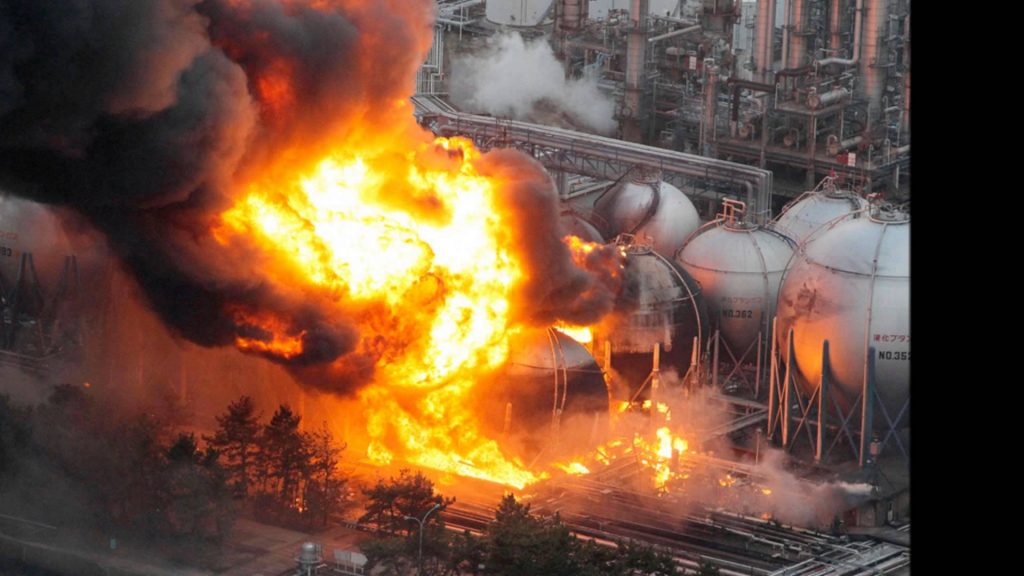Natural disasters are very common but tragic events around the world. From earthquakes to tornadoes, geological disasters can cause increasingly damaging effects, affecting the landscape and those who find themselves there. But when these events are combined with man-made artifacts, the effects might be even greater. An example of this is the Fukushima Disaster in Japan, the worst nuclear disaster since the 1986 Chernobyl incident.1 But the cause of this horrific disaster wasn’t particularly a man-made event. In fact, it all started with a wave.

On March 11, 2011, an earthquake with a magnitude 9.0—the worst to ever hit Japan—hit the country. It was such a powerful catastrophe, that Japan’s main island, Honshu, was permanently moved more than two meters to the east. As the earthquake gained momentum, waves up to 40 meters began crushing the country’s coast. The effects of the earthquake and the waves were too much for the Japanese. More than 20,000 people died or went missing and hundreds of thousands more lost their homes.2 But the worst was yet to come. Fifty minutes after the initial earthquake, a ten-meter high sea wall hit the Fukushima Daiichi (Number One) nuclear power plant. The water flooded the plant’s emergency power generators, knocking vital cooling systems offline, triggering a meltdown of reactor fuel rods. These then leaked deadly radiation into the coastal atmosphere of Japan. With the cooling systems not working, hydrogen gas built up in the reactor buildings, causing several hydrogen explosions in the following days of the earthquake.3

Because of the highly toxic radioactive material that leaked to the surrounding areas of the power plant, the government began to evacuate 80,000 people from a twelve-mile radius. Technicians turned to several things to try to cool the nuclear fuel, like using fresh water, seawater, and injecting nitrogen into the reactor containment buildings to prevent further explosions.4 But despite the efforts to try to help the people of Honshu, the government didn’t tell the people the truth. The official statistics of the event and even the admittance that the meltdown had taken place weren’t disclosed until eighty-eight days later.5
It was estimated that more than 800,000 tons of highly-radioactive material sat near the accident, which was slowly getting into the ground and moving towards the ocean. Although many people were evacuated, there were still many that couldn’t leave. The government installed temporary housing that was intended to house tens of thousands of people after the disaster for twenty-four months. But five years after the disaster, thousands of people were still living where they were surrounded by the radioactive material. Many of those who remained were the elderly and low-income families who had few options to move away.6

Several months after the disaster, people in other parts of Japan began rallying to help these people and bring an end to nuclear power plants in Japan. This pushed forward for the closure of all of the other nuclear plants in Japan for maintenance and inspection.7 These protests also pressured the government to issue a report on the disaster at Fukushima. This report criticized TEPCO (the Tokyo Electric and Power Company) for failing to address concerns about safeguards at the plant. This report also included information about how TEPCO officials had ignored engineers’ concerns that a seawall constructed to protect against major tsunamis as they had seen on March 11 was not sufficient. The report additionally criticized safety regulators for not implementing proper safety measures and for failing to adopt global nuclear safety standards.8 This was really important for the Japanese because TEPCO had always emphasized that the nuclear generators were “fail-safe,” that the facility was completely earthquake resistant and that the reactors would be able to withstand a major tremor.9
Five years after the disaster in Japan, several policies were changed to address the rising concerns of the Japanese population regarding nuclear power plants. The major decision of this kind was the decision to phase-out nuclear power plants during the 2030s as part of Innovative Strategy for Energy and the Environment adopted by the cabinet of the Democratic Party of Japan (DPJ).10 TEPCO is still facing criticism regarding the amount of nuclear material that was leaked into the environment and it is estimated that cleanup operations could take up to forty years.11
- Will Ripley, Junko Ogura, and James Griffiths, “Fukushima: Five Years after Japan’s Worst Nuclear Disaster,” CNN, March 11, 2016, sec. World. ↵
- Encyclopedia Britannica, 2018, s.v. “Fukushima Accident.” ↵
- New World Encyclopedia, 2017, s.v. “Fukushima nuclear disaster.” ↵
- New World Encyclopedia, 2017, s.v. “Fukushima nuclear disaster.” ↵
- Will Ripley, Junko Ogura, and James Griffiths, “Fukushima: Five Years after Japan’s Worst Nuclear Disaster,” CNN, March 11, 2016, sec. World. ↵
- Will Ripley, Junko Ogura, and James Griffiths, “Fukushima: Five Years after Japan’s Worst Nuclear Disaster,” CNN, March 11, 2016, sec. World. ↵
- New World Encyclopedia, 2017, s.v. “Fukushima nuclear disaster,” ↵
- Encyclopedia Britannica, 2018, s.v. “Fukushima Accident.” ↵
- Akira Nakamura and Masao Kikuchi. “What We Know, and What We Have Not Yet Learned: Triple Disasters and the Fukushima Nuclear Fiasco in Japan,” Public Administration Review 71, no. 6 (2011): 894. ↵
- Rie Watanabe, “After the Fukushima Disaster: Japan’s Nuclear Policy Change from 2011 to 2012,” Review Of Policy Research 33, no. 6 (2016): 623. ↵
- Alexis Dudden, “The Ongoing Disaster,” The Journal of Asian Studies 71, no. 2 (2012): 349. ↵




111 comments
Michael Hinojosa
This article is extremely informative and shed some light on the situation better than the news had (in my opinion at least). I do remember seeing this on the news and trying to understand just what the severity of all the fallout was since back then I didn’t really know how nuclear power worked, but after reading this article and learning about this event in my geology class I’m disgusted to know the company wasn’t being safe with this kind of power and innocent lives paid the price.
Max Lerma
I remember when this devastating event occurred and hearing the news reports of the fallout from it for months after it actually took place. Despite having lived while this was happening, your article was very interesting and a great reminder of the damage done by the tsunami and plant’s lack of safeguards. This article is also a sobering reminder of the need for all nations to better regulate nuclear power.
Alexander Manibusan
I think this partly why people fear using nuclear power as a power source. While they might be protected, there is always a way that can potentially unravel a grave disaster. I find it ridiculous that TEPCO ignored the concerns of the engineers and that it did not implement global nuclear safety standards. That is just ludicrous- I do hope that they learn from this.
Katherine Watson
This world honestly becomes scarier and scarier with every day that passes. I was only 11 when this happened but have no previous knowledge of this up until right now. I never thought about the dangers that could arise from having a plantation in an area where natural disasters are frequent. Mother nature is a powerful force to be reckoned with, and it is very peculiar for us to keep trying to alter our surroundings with the latest technology because climate change is a real thing and we are only increasing our chances of these natural disasters. Plus, our world is beautiful as it is and we keep ruining it by competing with one another to have the most prominent and boldest weapons on the planet. Honestly, I have lost hope in this world for future generations, but it’s okay. Everything is fine.
Daniela Cardona
The disaster in Japan is one that still lives vividly in my brain. To watch the events fold out on television was heart breaking, but I had little information on the extent of the nuclear reactor disaster at Fukushima. This article laid out the tragedy that was the Fukushima disaster very well and gave me a lot of insight into the catastrophe that left thousands in harms way because of one company’s careless actions.
Karina Cardona Ruiz
Nice job on researching and writing about this topic. I can understand how the government could have thought that not telling the public right away about what happened would avoid panic. However, I don’t think it was right of them to withhold that information especially considering they waited 88 days to disclose any of it. Hopefully Japan’s government can learn from the mistakes they’ve made and implement better safety regulations to avoid something like this happening again.
Didier Cadena
This was a very interesting article. Before reading the article, I did not know the extent of this whole ordeal. I do remember the earthquake and the plants failure, but I was not aware of the whole extent of this situation. It is sad to read about how so many people either loss their lives or homes because of this. The article does a great job of putting all of the information together and still make it interesting to read.
Lorenzo Rivera
This article is so well written and was extremely interesting to read about. It is really heartbreaking that those people had to sit in that environment. Inhaling that type of toxin can cause birth defects in future generations. Also, I feel as if the government didn’t do enough to take care of it’s people. 10 years passed by and people were still living in an infested environment. Overall great detain on the disaster, as well as its aftermath.
Ethan Rodriguez
As a science major, I am completely interested in nuclear sciences and the events that unfolded because of them. I think one of the most nerve racking natural disasters someone can encounter is an earthquake, solely because of just how powerful they can be. You see them on the news and being from a southern state, the likelihood of the plates shifting down here is unlikely. However after reading this article, I felt truly devastated for Japan and its populations. This is something that truly tears a country apart. I hope that they never have to experience anything like this ever again. The article was clear and I enjoyed the images and the writing style as it kept my attention and allowed for me to completely understand all of the information in the article.
Harashang Gajjar
It’s been one of the mysteries of Japan’s ongoing nuclear disaster: How much of the damage did the March 11 earthquake inflict on Fukushima Daiichi’s reactors in the 40 minutes before the devastating tsunami arrived? The stakes are high: If the quake alone structurally compromised the plant and the safety of its nuclear fuel, then every other similar reactor in Japan is at risk.